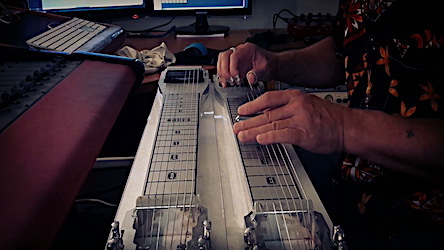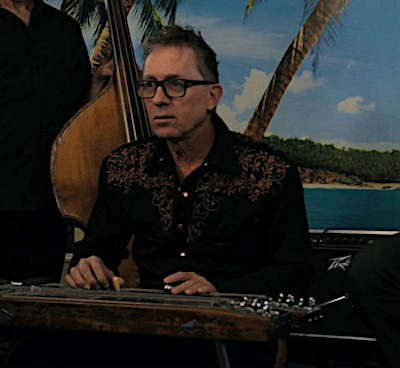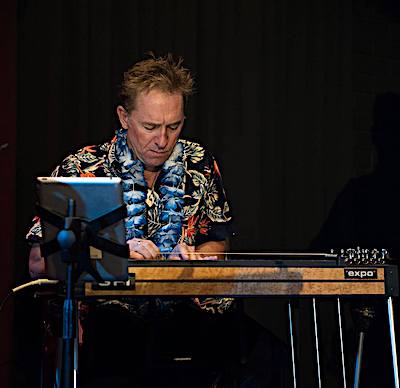 
|
||||
|
|
THE SOUTH PASIFIKA SOUND PROJECT |
|||
|
mwe3.com presents an interview with
Paul Agar: I grew up in Auckland, New Zealand and learned to play ukulele when I was six or seven. I moved onto guitar at the age of 10. I was totally self-taught, having been given a six-string guitar and a book of chords. I found that I could listen to a piece of music and work out the chords. By my mid-teens, I was listening to an eclectic mix of folk, country rock, pop and prog-rock music. I would have to say that the band that informed me and my music the most about melody and harmony would be The Beatles. Growing up in New Zealand also meant being exposed to a range of Polynesian styles of music including Maori sing-along classics like Pokarekare Ana and Hoki Mai as well as island (Samoa, Tonga, Cook Islands) church choir music and chants. Auckland, in particular, has a broad and vibrant group of ex-pat Pacific Island communities and so we were always surrounded by the music, art and food of these various cultures. mwe3: What was it like growing up New Zealand and what era did you first start playing in bands and what was some of your first music like? Paul Agar: My first foray into the Auckland music scene was as the lead guitarist with a post-punk/pop outfit called Vivid Militia sometime in late 1981. This was when I started writing pop-based songs as I now had a vehicle with which to perform them in public. Following the break-up of VM, I formed a band called Marginal Era in 1982. By this stage I was listening to a lot UK synth-based music like Simple Minds, Pete Shelley (ex-Buzzcocks), Depeche Mode et al. Marginal Era released two EP's. An instrumental piece from the first EP, "This Heaven" was picked up by the national television broadcaster and used as the opening titles theme for their weekly music program. One of the tracks off the second EP entered the national Top 40. The band also recorded a live concert for Television New Zealand. mwe3: When did you make the move from New Zealand to Australia and was making that move a good introduction to a larger audience? You worked with the great Ricky Fataar around that time too? What was that like? Paul Agar: In 1986, I left Auckland behind and relocated to Melbourne, Australia. I spent the first six months there writing intensely, shopping songs to publishers and record companies as well as searching for other musicians to form a working unit under the Marginal Era moniker. By early 1985, I had a record deal, with a Polygram Records subsidiary, a publishing deal with Warner-Chappell and a band. Stable mates on the record label included Scottish rockers Fiction Factory and blues legend Robert Cray.
By the end of 1986 however, the band had run its course and the members went their separate ways. I performed as a solo artist over the next six months or so and then began performing as a freelance guitarist and bass player for a number of "cover" bands. mwe3: When did you start getting into recording music and working in the studio? Paul Agar: As part of the song-writing process, like many other musicians I had a 4-track port-a-studio recorder that I used to sketch out my compositions. During the early 1990's I was asked by a band mate if I could bring my 4-track into the Melbourne Juvenile Justice Centre, where he worked and run a series of song-writing and recording workshops. This turned into a six year off and on work in progress with some fantastic outcomes. Looking back, this was the genesis of my later recording and production work. In the early 2000's, after having relocated to the New South Wales North Coast, I set up a purpose-built recording studio to accommodate the requests from various artists for recording as well as to cater for my own musical projects. My engineering and production work has led to a number of regional, North Coast Entertainment Industry music awards including the following: 2001 Winner, Best Male Vocal Award
Paul Agar: During the years 2009 - 2010 I spent a large amount of time co-composing and recording for the kid’s TV series ‘DirtGirlWorld’ broadcast in 128 countries, including CBeebies in the UK, CBC in Canada and PBS kids Sprout in the US. This was a very successful production, going on to win a raft of awards including2010 Winner, Australian Film Industry (AFI) for Best Children's Animation Series and 2013 International Digital Emmy for Children and Young People Category. It was during this time that the show's producers asked me to include some "slide" guitar sounds for some of the musical transitions I was working on. Up to this point, I had only played bottleneck slide on a standard guitar, although I was familiar with the pedal steel and lap steel sound. After borrowing a six-string lap steel and starting to nut out some sounds, I had what might well be called an epiphany! I was hooked on the Steel Guitar. From this moment on, I made a conscious decision to learn the instrument. The first thing that I needed, obviously was a Steel Guitar. So, I started looking through the classifieds, gumtree, eBay etc. Finally, I came across a Shobud "Maverick" pedal steel guitar for a price not much more than a standard 6 string lap steel. I figured that if I couldn't work out how to operate the pedals and single lever, then I'd just play it like a lap steel. Now, for anyone who has caught "the bug" of the pedal steel, they will know that what lies ahead is a journey fraught with anguish, sweat and sleepless nights!
Paul Agar: Playing Pedal Steel Guitar requires a different approach to that non-pedal steel - lap and console - as it is a mechanical device with multiple foot pedals and knee levers. From 2010 onwards, I immersed myself in pedal steel and this came in quite handy whenever I was working on country music flavoured projects. From there I began to look more closely at the Hawaiian genre and body of work. This is unusual as many steel players start off on non-pedal guitars, learn some Hawaiian standards then move on to the more complicated pedal steel. So, I came at Hawaiian steel guitar backwards! Currently, I have one main pedal steel - a 10-string Zum Steel single deck 4 X 5 - 4 pedals, 5 knee levers. The tuning on that guitar is E9th. I own two console guitars, both twin decks. One is an Excel Jerry Byrd model with Lace Alumitone pickups that sound really fat! This is the principal guitar featured on Across The Pacific. The other one is a 1954 Fender Dual Pro. Both console guitars have two tunings: C6th, developed by Jerry Byrd in the late 1930's and E13th, Leon McAuliffe's tuning. One other guitar I have is a mid - 70's Guya lap steel that I have tuned to B11th. For my production work I have the usual go-to guitars - Fender Stratocaster and Telecaster, Martin acoustic plus a banjo and a resonator. Changing strings on steel guitars is not that hard, the main problem is there are so many of them! If I have to change strings on one of the twin decks, that's sixteen strings in one hit. mwe3: I always think of Pedal Steel as being more complicated than regular steel as well as Lap Steel guitar. What are the differences between various Steel guitars and can you compare the sound of Pedal Steel with that of regular 6 or 12 string guitars? Who are some of your favorite “steelers” and do you have some favorite steel guitar albums?
One other major difference between steels and standard guitars is the tuning, for a couple of reasons. Firstly, there are at least half a dozen or more commonly used tunings for steel guitars. Secondly, steel tunings, especially pedal steel, are tempered. This is because all the strings are the same length from nut to bridge, unlike a standard guitar which has a slanted bridge or adjustable saddles. To me, the big difference between steel guitar and standard six and twelve string fretted guitars is the kind of expression that can be produced. Particularly on slower ballad-style songs, a good player can make the steel guitar "cry". Maybe that's what George Harrison had in the back of his mind when he wrote "While My Guitar Gently Weeps"! In terms of favorite steel guitar albums, for pedal steel it would be anything by Lloyd Green ("Mr Nashville") or Paul Franklin. For non-pedal steel, the two biggest influences on my playing have been Jerry Byrd and Jules Ah See. mwe3: What other soundtrack music have you done in recent years? Paul Agar: From about 2005 onwards, I began to compose "production music" - pieces of mainly instrumental music for use as backgrounds for film, radio, gaming and other commercial products. These works are licensed through a third-party company and I've been fortunate to have compositions synched to a number of TV shows and films like Through The Wormhole with Morgan Freeman (2015) andIn Vino (2017) Winner (Jury Prize): Best Comedy Feature, Hollywood Film Festival 2017, amongst others. Interestingly, it is the Hawaiian-style pieces that are the most frequently licensed! mwe3: You also work with some other bands in Australia? What other recent live work have you done and have these other bands recorded or played concerts?
In 2019, I was invited to perform at the Waikiki Steel Guitar Festival. This was mind-blowing as I got to meet some awesome steel players like Alan Akaka, Scott Furushima and Greg Sardinha. These players, especially Alan, through his organisation HIMELE, are carrying out a crucial role in the restoration and continuance of Steel Guitar music, including the implementation of education programs in local Hawaiian high schools. mwe3: You’ve had a most impressive career. So, to my ears it sure sounds like your 2020 album Across The Pacific by your band The South Pasifika Sound Project is pinnacle of your career. What events led to the album creation and what was your overall plan or sonic vision for the Across The Pacific album? I guess the question I have is: why did it take you so long to make an album this great? Why did you spell Pasifika like that? Paul Agar: The idea for this project came to me several years ago. By this stage, I'd been performing with Aloha Baby for three or four years and getting really immersed in Hawaiian music. I'd also been travelling through the South Pacific, off and on since about 2010. In all the places I've been to in the South Pacific, I have never seen nor heard any steel guitar although I am told there are some good players in French Polynesia, but I'm yet to visit that part of the world. So, the idea of a "marriage" of the two elements of steel guitar and sounds of Pasifika developed. An over-arching vision for The South Pasifika Sound Project is the preservation and promotion of the steel guitar through the creation of a number of compositions that may be broadly termed "Pasifika". The term "Pasifika" is a collective noun that generally applies to nations of the South Pacific ocean, particularly Polynesia. The aim is to create music that features steel guitar as the principal, or lead, instrument but does not reflect only the Hawaiian tradition but is, in fact, inclusive of the wider Pacific, in particular South Pacific cultural influence. This would include music from Tonga, Samoa, Cook Islands, French Polynesia and New Zealand amongst many others. These compositions are what you might call "modernized" or "contemporary" steel guitar music stylings - steel guitar music that makes a departure from the old traditional Hapa Haole style of the twentieth century. The intent is to present the steel guitar in a new and relevant construct. mwe3: When most listeners think of Steel Guitar, they think of American country music and/or Hawaiian music so is World Music a new genre that you bring into the Steel guitar world?
I find that the Steel Guitar is an exceptionally expressive instrument, much like the violin. Two primary factors that I've tried to deal with on this album have been tone and mood. As any steel player will tell you, tone is up there in the top five commandments of Steel Guitar - Thou shalt have good tone... or something like that. mwe3: What is the Steel Guitar connection to Polynesian music? I am glad you brought the focus of Polynesian music to the fore with Across The Pacific. Are you an expert on Polynesian music too? Paul Agar: In the twenty first century, if one was asked the question "what is the instrument that you mostly associate with popular Polynesian music?" Undoubtedly, the most common answer would be "the ukulele". However, this was not always the common perception. For most of the twentieth century, it was not the ukulele that characterised music from the Pacific but, in fact, the Steel guitar. While the ukulele was a development from the Portuguese 'braguinha", engineered in Hawai'i by immigrants from Madeira in the last quarter of the nineteenth century, the steel guitar was a style of playing, wholly developed/invented by a Hawaiian, in Hawai'i, Joseph Kekuku. mwe3: What fascinates you the most about the history of the Steel guitar? Paul Agar: The history of the steel guitar, from a Hawaiian perspective, describes an incredible global rise in popularity, sustained for nearly six decades until a wane and eventual nadir by the 1970's. For the last thirty years, the art of playing steel guitar has been perpetuated by a small band of enthusiasts around the world. Two giants amongst them, with regard to keeping the tradition alive, have been Jerry Byrd (1920 - 2005) and Alan Akaka, both based in Hawai'i. Alan Akaka's organisation HIMELE (Hawaiian Institute for Music Enrichment and Learning Experiences) actively conducts and promotes steel guitar music through school programs and by organizing and sponsoring festivals. The hope is that the steel guitar, an instrument once considered at-risk because of the secrecy behind its tuning and playing, will make a come-back. mwe3: How long did it take you to compose and record the music for the Across The Pacific album tell us who helped you make the album? What tracks were done first and tell us about the log drumming of Bobby Alu and the other drums sounds and loops? The drums sound very live and powerful to my ears. Who did the album mastering and how did that enhance the overall sound? It’s very crisply recorded which is often in contrast to other steel and pedal steel albums and who is playing the tambourine?
Most of the drum sounds for the album are produced from a program called Superior Drummer, which I use a lot in my production work. The sounds are based on grooves recorded with world-class session drummers in world-class studios, in this case, Avatar, in New York City. I used Reason for some of the ambient percussion loops and I played all tambourine and shaker tracks myself. The album was mastered in Byron Bay by Paul Gomersall, engineer and producer for George Michael, Phill Collins, Robert Palmer, Eric Clapton and Mary Black amongst others. Paul relocated from London to Australia in the 1990's and focuses on mastering these days. mwe3: Tell us about the album cover art for Across The Pacific and is there a message in the artwork? Your track-by-track liner notes are great and shed a light on the history of that region of the world. Are you an expert on that region of the world? It’s cool that you grew up in that part of the world. Paul Agar: Wherever you travel in the South Pacific, you'll see the sea turtle, gentle giants slowly cruising by. The album art highlights - in a stylised way - three things that unite Pasifika, the sea, the Southern Cross constellation and the sea turtle! If you live in either New Zealand or on the east coast of Australia, you are right on the doorstep of the mighty South Pacific Ocean and it's myriad of cultures. I'm definitely no expert on the region but it is a place that I love to travel through. mwe3: Tell us what other instruments you’re playing on Across The Pacific. There’s also some ukulele and what about the other guitars you play on the album? Who else is featured on the album and tell us about the various chanting as it adds such an exotic touch to the overall sound?
Most of the chanting on the album is drawn from traditional choral song and hymns of Tonga, Samoa and the Cook Islands. The chant on the track "Tarawera" is part of a karanga, a call out or summon, typically an element of cultural protocol of the Maori people of Aotearoa in New Zealand. In this instance it is both a warning and a tribute to the dead following the 1886 eruption of Mount Tarawera on New Zealand's North Island. mwe3: Tell us something about your record label EggSonix and how you came up with that name and logo and tell us something about your Heaven Recording Studio? Is it a state-of-the-art studio and can you tell us something about the way you recorded Across The Pacific there? Did you do a lot of overdubbing and were there other out takes that didn’t make the final cut? Paul Agar: The EggSonix label mainly exists as a conduit for personal projects that I'm involved with. The name comes from the first project, "The Universal Egg" that was released back in 2001. Other releases have included an EP by alt-country rockers Doot and a remastering of an album by Marginal Era. All of these works have been created at Heaven Recording Studios, which has had a couple of incarnations over the years. The most recent was a purpose built acoustically designed facility at Yamba, south of Byron Bay in New South Wales. It had a great sounding live room, vocal booth, iso room as well as a large and accurate sounding control room. Unfortunately, the Covid downturn meant that the building had to be sold, in late 2020. Currently, I have a smaller facility where I'm mainly working on mix and mastering projects. The recording process for the South Pasifika Sound Project album was fairly straight forward. It was largely a process of over-dubbing and layering, building the songs up into distinct sections, then setting out the arrangement. This, I suppose, is a bit of a departure from a more "live" form of recording whereby the band usually has the arrangement in place before recording. With regard to recording the individual instruments, I have particular microphones that I prefer for different instruments, my go-to brands being Neumann, AKG plus Shure and Cascade for Steel.
Paul Agar: As I was nearing completion of the final mixes of the album, I definitely felt that, in terms of the Steel Guitar genre, this was something new and fresh. To my ears, it's somewhat of a break with the Hawaiian tradition but still distinctively steel guitar music. Along the way, it's been a process of exploration and experimentation but I'm really happy with the outcome! I would love to present The South Pasifika Sound Project as a live show, featuring log drumming and dancers. Everything is still up in the air in terms of live entertainment, due to the ongoing pandemic but I think the SPSP would make an awesome festival act! One other plan on the drawing board is to spend some time in Kiribati which is in the equatorial part of the Pacific and record some of the traditional music there. One can dream...
|
|
|||
|
||||

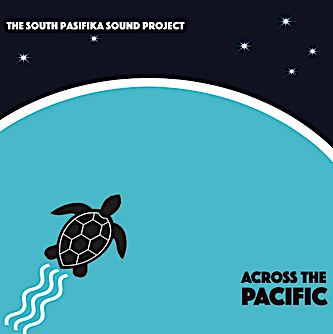 Australian-based pedal steel guitarist Paul Agar breaks new ground for a range of musical genres with the 2021 CD release of Across The Pacific. The debut release to feature Paul’s latest musical project, The South Pasifika Sound Project, Across The Pacific finds Paul working with various contributors to the recordings, including Australian/Samoan rhythm superstar Bobby Alu on log drum and percussion, Maori songstress Rewa Ututaonga, performing Karanga (Maori chant), and the Whitireia Performance Centre Choir performing the Cook Island chant. Elevating the sound to higher heights, the album also features Paul’s use of sound loops that features a range of session drummers. A delightful and sonically pleasing set of music that features truly ear-opening and wildly diverse sounds, the 8-track, 45-minute Across The Pacific blends steel guitar-centric vibes with a number of evocative genres that merges a variety of sounds from World Music to jazz and even the late 1950’s twang of New York City’s legendary steelers Santo & Johnny. Adding to the exotic South Pacific and Hawaiian instrumental guitar vibes, the addition of atmospheric Maori and Polynesian chanting on several tracks enhances the exotic rhythms and percussion. I could see fans of Martin Denny, Les Baxter and even guitar hero Les Paul’s also enjoying Paul Agar’s music. Filling out the steel guitar sound, Paul also adds in other guitars, keyboards and programming that enhances the World and jazz-based styles. Highlights of Across The Pacific are numerous, including track 4 “Matapa”, the Shadows / Hank Marvin sound of “Anahulu”, the tropical flair meets Beatles vibe of “Tagaqe” (pronounced Tang-a-gay), and the ethereal album-closer “Tarawera”. While available as a digital album on Amazon, listeners that still appreciate physical releases are well advised to pick up the CD of Across The Pacific as the artwork and packaging is superbly done, while also featuring track by track notes by Paul. The mix of Paul Agar’s atmospheric steel guitar with the intriguing log drum sounds and exotic indigenous vocal chanting makes Across The Pacific an essential instrumental listening experience.
Australian-based pedal steel guitarist Paul Agar breaks new ground for a range of musical genres with the 2021 CD release of Across The Pacific. The debut release to feature Paul’s latest musical project, The South Pasifika Sound Project, Across The Pacific finds Paul working with various contributors to the recordings, including Australian/Samoan rhythm superstar Bobby Alu on log drum and percussion, Maori songstress Rewa Ututaonga, performing Karanga (Maori chant), and the Whitireia Performance Centre Choir performing the Cook Island chant. Elevating the sound to higher heights, the album also features Paul’s use of sound loops that features a range of session drummers. A delightful and sonically pleasing set of music that features truly ear-opening and wildly diverse sounds, the 8-track, 45-minute Across The Pacific blends steel guitar-centric vibes with a number of evocative genres that merges a variety of sounds from World Music to jazz and even the late 1950’s twang of New York City’s legendary steelers Santo & Johnny. Adding to the exotic South Pacific and Hawaiian instrumental guitar vibes, the addition of atmospheric Maori and Polynesian chanting on several tracks enhances the exotic rhythms and percussion. I could see fans of Martin Denny, Les Baxter and even guitar hero Les Paul’s also enjoying Paul Agar’s music. Filling out the steel guitar sound, Paul also adds in other guitars, keyboards and programming that enhances the World and jazz-based styles. Highlights of Across The Pacific are numerous, including track 4 “Matapa”, the Shadows / Hank Marvin sound of “Anahulu”, the tropical flair meets Beatles vibe of “Tagaqe” (pronounced Tang-a-gay), and the ethereal album-closer “Tarawera”. While available as a digital album on Amazon, listeners that still appreciate physical releases are well advised to pick up the CD of Across The Pacific as the artwork and packaging is superbly done, while also featuring track by track notes by Paul. The mix of Paul Agar’s atmospheric steel guitar with the intriguing log drum sounds and exotic indigenous vocal chanting makes Across The Pacific an essential instrumental listening experience.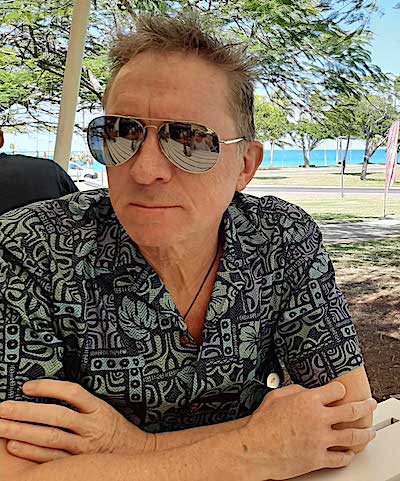 mwe3: Tell us where you grew up and what was some of the music you first experienced? What rock and pop artists had a big influence on you early on and when did you first start playing guitar and start composing music?
mwe3: Tell us where you grew up and what was some of the music you first experienced? What rock and pop artists had a big influence on you early on and when did you first start playing guitar and start composing music?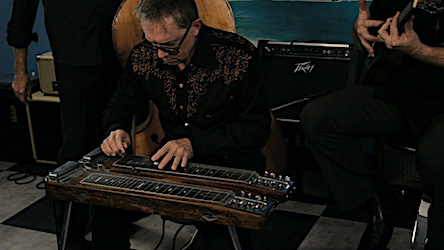 The next twelve months was a mix of recording and touring. The Australian version of the band had a harder, rockier feel to the music, a reflection of burgeoning pub-rock scene at the time. Marginal Era's debut Australian album was produced by Mark Moffatt (Keith Urban, Tony Joe White) and Rikki Fataar (Beach Boys). It was an exciting time working with Mark and Rikki, two of the nicest guys in the business, in some of Australia's best studios at the time. Incidentally, this was the first time I had seen a pedal steel guitar up close, as Mark is an accomplished "steeler".
The next twelve months was a mix of recording and touring. The Australian version of the band had a harder, rockier feel to the music, a reflection of burgeoning pub-rock scene at the time. Marginal Era's debut Australian album was produced by Mark Moffatt (Keith Urban, Tony Joe White) and Rikki Fataar (Beach Boys). It was an exciting time working with Mark and Rikki, two of the nicest guys in the business, in some of Australia's best studios at the time. Incidentally, this was the first time I had seen a pedal steel guitar up close, as Mark is an accomplished "steeler".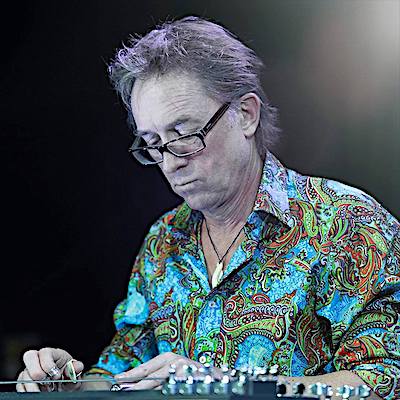 mwe3: You also got into writing music for television at that time too? Did that lead you to discover the Pedal Steel guitar around that time?
mwe3: You also got into writing music for television at that time too? Did that lead you to discover the Pedal Steel guitar around that time?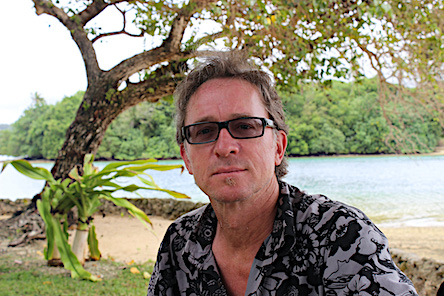 mwe3: What were some of the challenges in mastering the art of Pedal Steel guitar and how many Pedal Steel or regular steel and lap steel guitars do you have? What about other guitars you have in your studio collection? How hard is it to change strings on the Pedal Steel?
mwe3: What were some of the challenges in mastering the art of Pedal Steel guitar and how many Pedal Steel or regular steel and lap steel guitars do you have? What about other guitars you have in your studio collection? How hard is it to change strings on the Pedal Steel?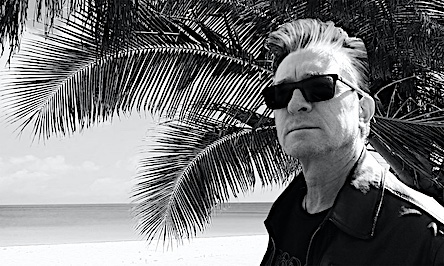 Paul Agar: I used to think that pedal steel guitar was harder to play than non-pedal but I'm not so sure about that. The thing with non-pedal steel is that the player is required to perform what we call bar slants. One needs to use that technique otherwise you are limited as to how many chords you can play. Speed and accuracy when performing slants is paramount. The development of the pedal steel guitar was a solution to doing away with bar slants! Rather than slanting the bar, all you now had to do was to depress a pedal or engage a lever.
Paul Agar: I used to think that pedal steel guitar was harder to play than non-pedal but I'm not so sure about that. The thing with non-pedal steel is that the player is required to perform what we call bar slants. One needs to use that technique otherwise you are limited as to how many chords you can play. Speed and accuracy when performing slants is paramount. The development of the pedal steel guitar was a solution to doing away with bar slants! Rather than slanting the bar, all you now had to do was to depress a pedal or engage a lever.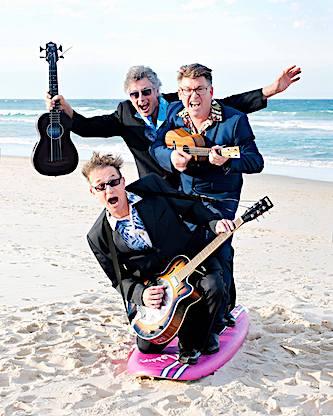 Paul Agar: For the past six years, I've played Steel Guitar for the Australian-based group Aloha Baby. Always musically adventurous, Aloha Baby launched their career in 2016, releasing their debut album of Hawaiian classics in 2018. They continue to break new ground with their collaboration with Na Pua O Australia, the wonderful Hula dancing troupe from Queensland's Gold Coast. In 2017 and 2018 they performed at a range of festivals in New South Wales, Victoria and Queensland, also appearing at the iconic Port Fairy Folk Festival in both 2018 and 2020.
Paul Agar: For the past six years, I've played Steel Guitar for the Australian-based group Aloha Baby. Always musically adventurous, Aloha Baby launched their career in 2016, releasing their debut album of Hawaiian classics in 2018. They continue to break new ground with their collaboration with Na Pua O Australia, the wonderful Hula dancing troupe from Queensland's Gold Coast. In 2017 and 2018 they performed at a range of festivals in New South Wales, Victoria and Queensland, also appearing at the iconic Port Fairy Folk Festival in both 2018 and 2020. 